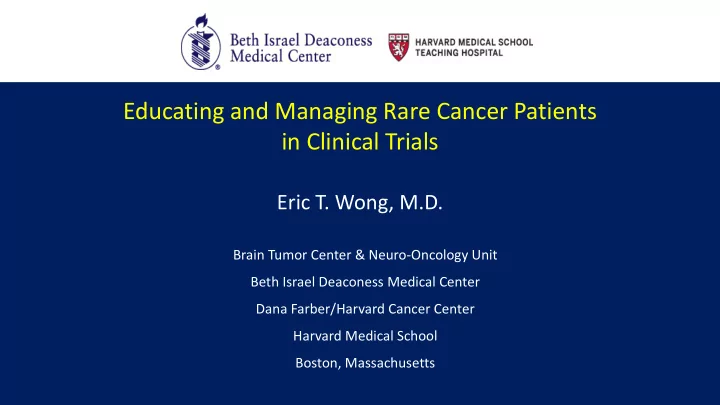

A teaching hospital of Harvard Medical School Educating and Managing Rare Cancer Patients in Clinical Trials Eric T. Wong, M.D. Brain Tumor Center & Neuro-Oncology Unit Beth Israel Deaconess Medical Center Dana Farber/Harvard Cancer Center Harvard Medical School Boston, Massachusetts
Definition of Rare Cancers https://www.cancer.gov/publications/dictionaries/cancer-terms/def/791790 Definition • A rare disease is any disease affected fewer than 200,000 Americans (<1% Common vs Rare Cancers of population in United States) • Breast Cancer (female) vs Breast Cancer (male) • A rare cancer is any cancer affecting • Prostate Cancer vs Urethral Carcinoma fewer than 15 out of 100,000 people • Lung Cancer vs Small Cell Lung Cancer per year or less than ~45,000 • Skin Cancer vs Stage III, IV Metastatic Americans per year Melanoma • Colorectal Cancer vs GIST
A Few Examples of Rare Cancers Hematologic Malignancies Nervous System Cancers • Leukemias Glioblastoma (Grade IV Astrocytoma) • • ALL, CLL, AML, CML • Anaplastic Astrocytoma • Hodgkin Lymphoma • Low Grade Glioma • Large B-cell Lymphoma • Medullablastoma • Myelofibrosis • Meningioma Metastatic Brain Tumors • Soft Tissue Tumors Organ Specific Tumors • Alveolar Soft Part Sarcoma • Clear Cell Sarcoma Breast Cancer (male) • • Desmoid Tumors Urethral Carcinoma • • Kaposi Sarcoma Small Cell Lung Cancer • • Malignant mesenchymoma Thyroid Cancer • Adrenocortical Carcinoma •
Why Participate in a Clinical Trial? Advancing science No treatment available Current treatment not safe Access to new treatment Other reasons (i.e. minority, Current treatment not effective registry for disease, risk factors)
Common vs Rare Cancer Trials Common Cancers Rare Cancers Phase 1 10-100 patients 5-20 patients Phase 2 100-500 5-40 Phase 3 500-5000 10-500 Inclusion Criteria Very strict Strict Exclusion Criteria Very strict Strict Number of locations Numerous Few Recruiting patients Easier More Difficult
Talking to Patients About Clinical Trials Gather information During the meeting • Is there a clinical trial running? • Explain trial participation is voluntary • Check www.clinicaltrials.gov & other • It is helpful to repeat several times websites • Explain the disease, current treatment options • Is the patient likely eligible and then introduce clinical trial • • Check inclusion & exclusion criteria • Use understandable terminology • Location from home & time commitment? • Listen to the patient (the patient needs to make • What type of clinical trial is it (phase I, II or an informed decision) III)? Schedule a meeting After the meeting • Quiet room with no interruptions • Reinforce the notion that the patient has rights • Invite caregiver, friends and/or relatives to • Schedule a call/meeting with the principal attend investigator or his/her staff • Make available pen, paper, laptop for a • Determine your role in helping the patient designated person to take notes National Institutes of health (NIH): Talking to Your Patient About a Clinical Trial . https://www.nih.gov/health-information/nih-clinical-research-trials- you/talking-your-patient-about-clinical-trial Accessed Aug 2019
How to Research Clinical Trials (www.clinicaltrials.gov)
Search Results (recruiting neuro-oncology trials): Three examples below Study Title Condition Intervention Locations Pembrolizumab and Recurrent Glioblastoma Phase II drug & radiation Beth Israel Deaconess Reirradiation in trial: Pembrolizumab + Medical Center; Dana- Bevacizumab Naïve and Radiation or Farber Cancer Institute; Bevacizumab Resistant Pembrolizumab + Massachusetts General Recurrent Glioblastoma Bevacizumab + Radiation Hospital Study to Evaluate Recurrent anaplastic Phase III drug trial: Beth Israel Deaconess Eflornithine + Lomustine astrocytoma Lomustine with or without Medical Center; Dana- vs Lomustine in Eflornithine Farber Cancer Institute; Recurrent Anaplastic Massachusetts General Astrocytoma (AA) Hospital Patients (STELLAR) Pivotal, Open-label, Brain metastasis from non- Phase III device trial: Beth Israel Deaconess Randomized Study of small cell lung cancer Radiosurgery with or Medical Center/Dana Farber Radiosurgery With or without Tumor Treating Harvard Cancer Center; Without Tumor Treating Fields Tufts Medical Center Fields (TTFields) (150kHz) for 1-10 Brain Metastases From Non-small Cell Lung Cancer (NSCLC)
Pros and Cons of Participating in a Clinical Trial Pros • Focused care with experts in the field • Advancing science • New treatment • Treatment not covered by insurer Cons • Travel expenses (reimbursement from NIH) • Time commitment • Presence of a placebo arm? (uncommon for cancer clinical trials) • Safety and efficacy trade offs?
Case Study of a Glioblastoma Patient 10/14/13 11/17/14 Patient • 56-year-old man • Recurrent glioblastoma • Patient has recurrence after standard treatment Pros and Cons • Patient wanted to be enter clinical trial 5/22/19 11/5/18 (Pembrolizumab + Bevacizumab + Radiation) but had some questions concerning: • Time commitment and travel to medical center • Cost • The impact the trial will have on work • Being treated by a different doctor (not an issue)
Summary • Gather appropriate information for the patient • Help him/her to make an informed decision • If a clinical trial is appropriate, set up an appointment with your patient and their caregiver to discuss (refer to modules 1 – 3 of this CME/CE series)
Recommend
More recommend